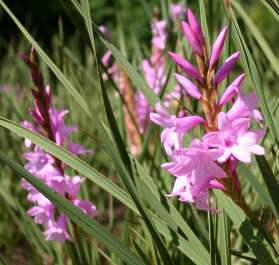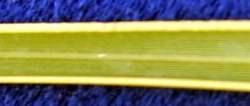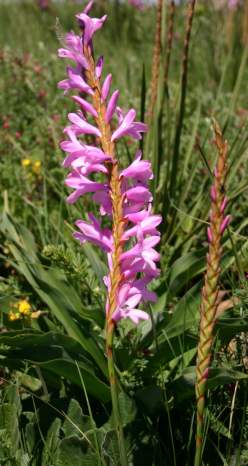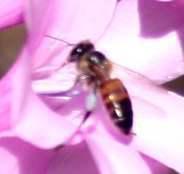Watsonia canaliculata
Watsonia canaliculata Goldblatt
Family: Iridaceae
Common names:
Introduction
Watsonia canaliculata is a lovely small, purplish-pink flowering Watsonia with unusual erect, grooved leaves. Rare and restricted to the KwaZulu-Natal Midlands, it is one of the more unusual members of a genus sought after by gardeners for its range of attractive flowers. Other members of this popular grassland family include well-known genera such as Dierama.

Description
Description
Watsonia canaliculata is a solitary, medium-sized, pink flowering plant up to 30-45 cm high. The leaves are erect, rigid, and clearly grooved, a unique feature among the Watsonia which characteristically have flat leaves.

The crowded spike of 10 to 25 pink to mauve flowers has coarse, dry, brown overlapping bracts. Flowering occurs in early summer (November and December).

The grey-brown corm is 2.5 to 4 cm in diameter.
A solitary plant with a comparatively short erect stem. W. canaliculata has been confused with W. densiflora , but the rigidly erect leaves, with the leaf margins curved inwards, giving the surface a channelled plane, clearly distinguish this species from W. densiflora. Also characteristic is its solitary habit, short stem with erect leaves, and its shorter flowering spike.
Conservation Status
Status
This species is listed as vulnerable (Scott Shaw 1999). It is endemic to the KwaZulu-Natal mistbelt which has been almost entirely transformed by industrial plantations, agriculture, and urbanisation.
Distribution and habitat
Distribution description
W. canaliculata is found in central KwaZulu-Natal. It grows in hard clay soils in protected areas in mist belt grassland around Greytown, New Hanover and Howick. It is reasonably resistant to frost.
Derivation of name and historical aspects
History
The specific name W . canaliculata refers to the uniquely channelled leaves. It was first collected by Friedrich Wilms, a German apothecary working in eastern Mpumalanga in 1883. He collected this species in the Midlands while travelling up from Durban on his way to Lydenburg. For many years it was confused with W. densiflora until recognised as distinct and described by Peter Goldblatt in 1989.
Ecology
Ecology
Nothing has been recorded about the pollination of W. canaliculata but, like other watsonias, it is probably pollinated by insects, particularly bees and long proboscid flies (such as Bombyliidae, Nemestrinidae, and Tabanidae). Sunbirds (Nectarinia spp.) and hawkmoths have also been observed nectar-sipping at flowering watsonias. Fire is believed to stimulate flowering and greater seed production.

Uses
Use
Use of W. canaliculata for medicinal purposes has not been recorded, but other species of Watsonia are popular for a variety of medicinal uses. W. densiflora is used in traditional medicine to treat diarrhoea and as a charm. It is not known whether the corm is edible as in W. latifolia.
Growing Watsonia canaliculata
Grow
Although little was previously known about growing W. canaliculata, staff at the KZN National Botanical Garden have been successfully harvesting the seed for several years. The seed is easy to collect and germinates easily. The seeds are sown on a watered medium-to-coarse pine bark growing mix in trays and then thinly covered with a layer of the same material. Most Watsonias grow well in nutrient-poor soils such as those resulting from sandstone, but a number of Western Cape lowland species grow in more acid granitic origin soils and in heavy clay soils. Watsonia canaliculata appears to prefer hard clay soils, but likes cooler, moist grassland conditions.
References
- Pooley, E. 1998. A Field Guide to Wild Flowers KwaZulu-Natal and the Eastern Region . Natal Flora Publication Trust.
- Rob Scott-Shaw, 1999. Rare and Threatened Plants of KwaZulu-Natal and neighbouring regions . KwaZulu-Natal Conservation Service.
- Goldblatt, P., and Manning, J. 1989. The genus Watsonia . Annals of Kirstenbosch Botanic Gardens. Vol.19. National Botanic Gardens.
Credits
Senzo Khanyile
Natal National Botanical Garden
January 2006
Plant Attributes:
Plant Type: Bulb
SA Distribution: KwaZulu-Natal
Soil type: Clay
Flowering season: Early Summer
PH: Acid, Neutral
Flower colour: Pink
Aspect: Full Sun
Gardening skill: Average
Special Features:
Horticultural zones









Rate this article
Article well written and informative
Rate this plant
Is this an interesting plant?
Login to add your Comment
Back to topNot registered yet? Click here to register.